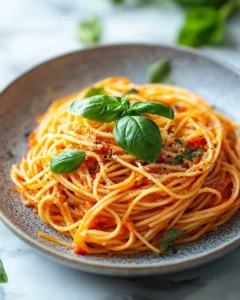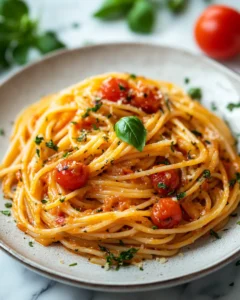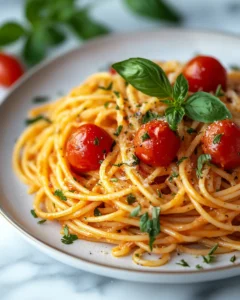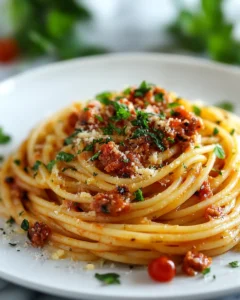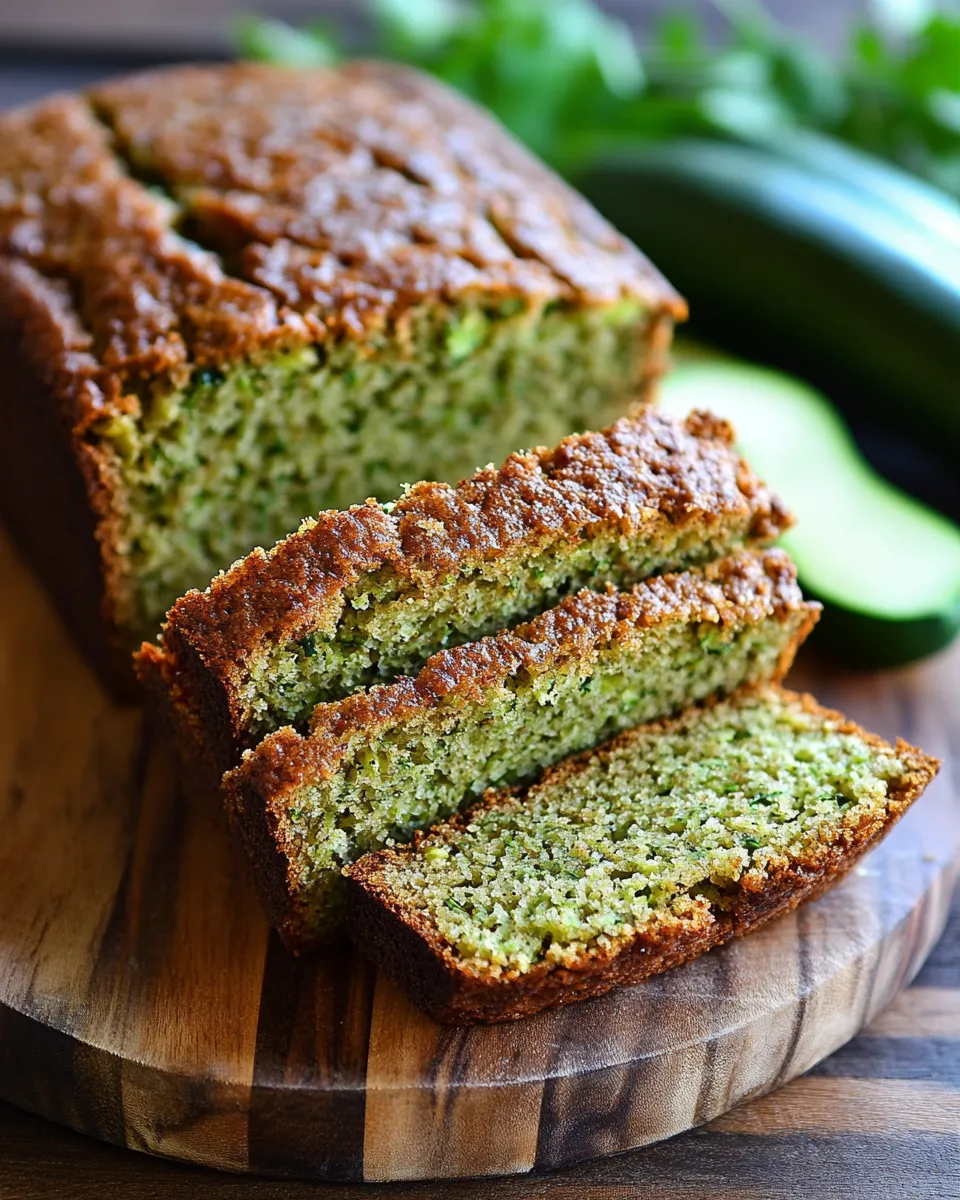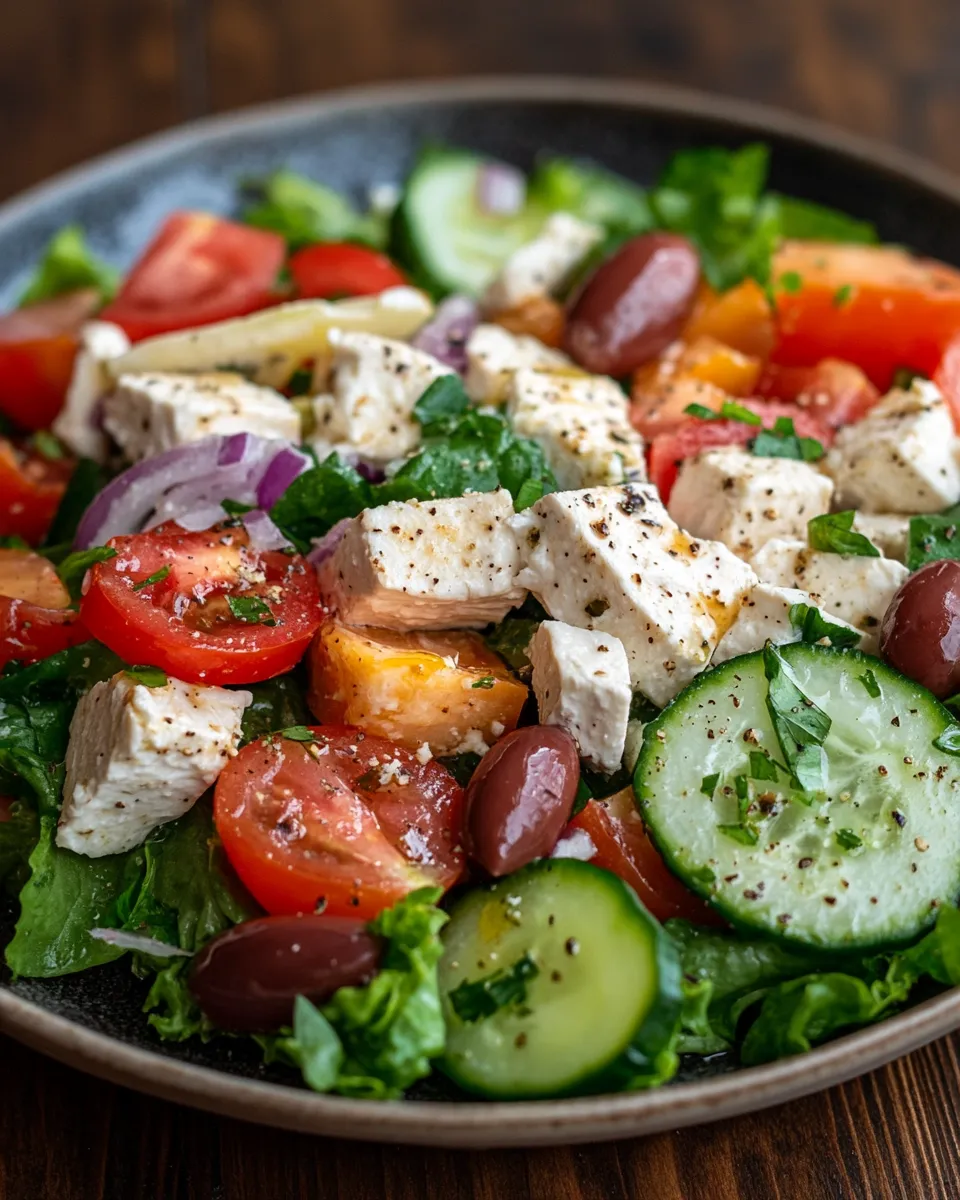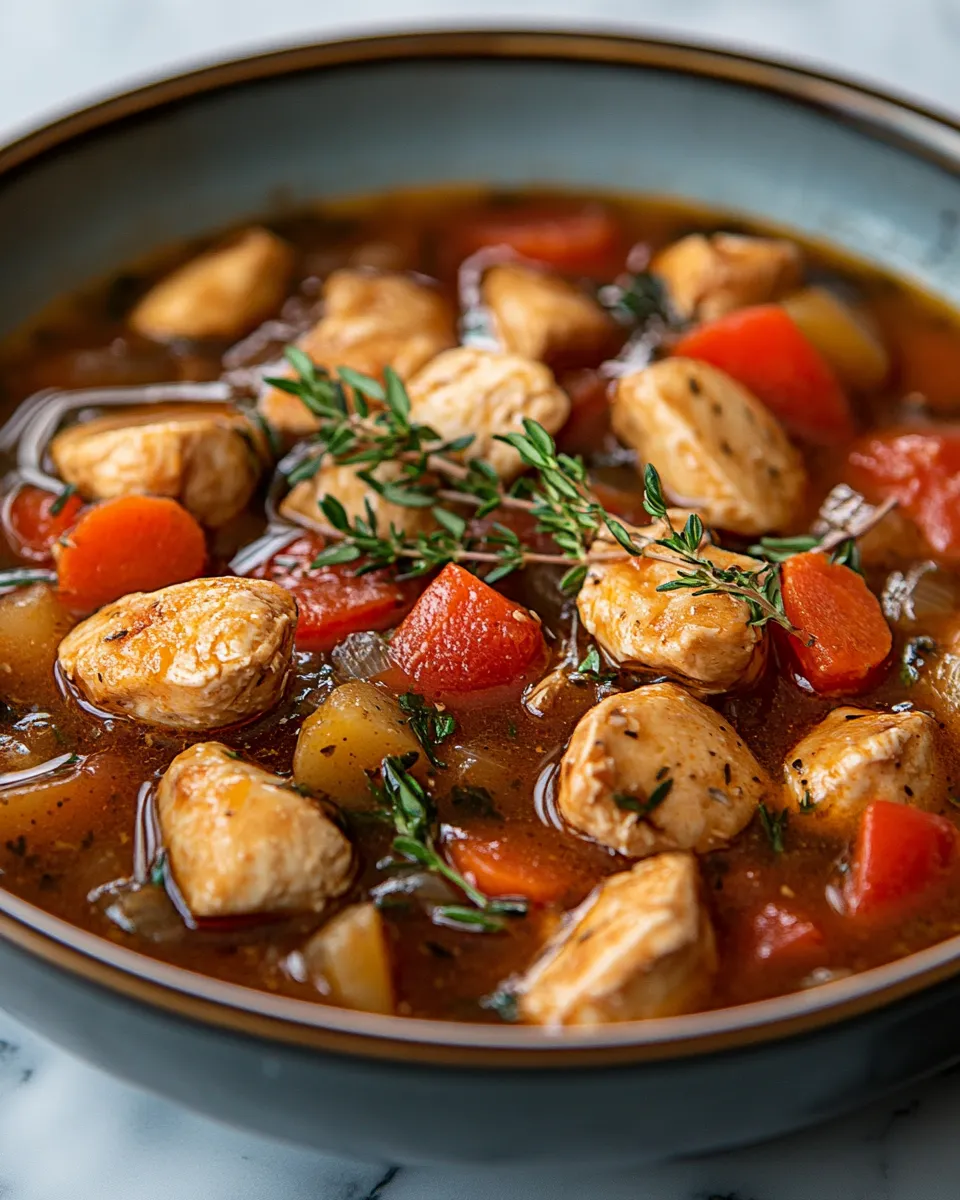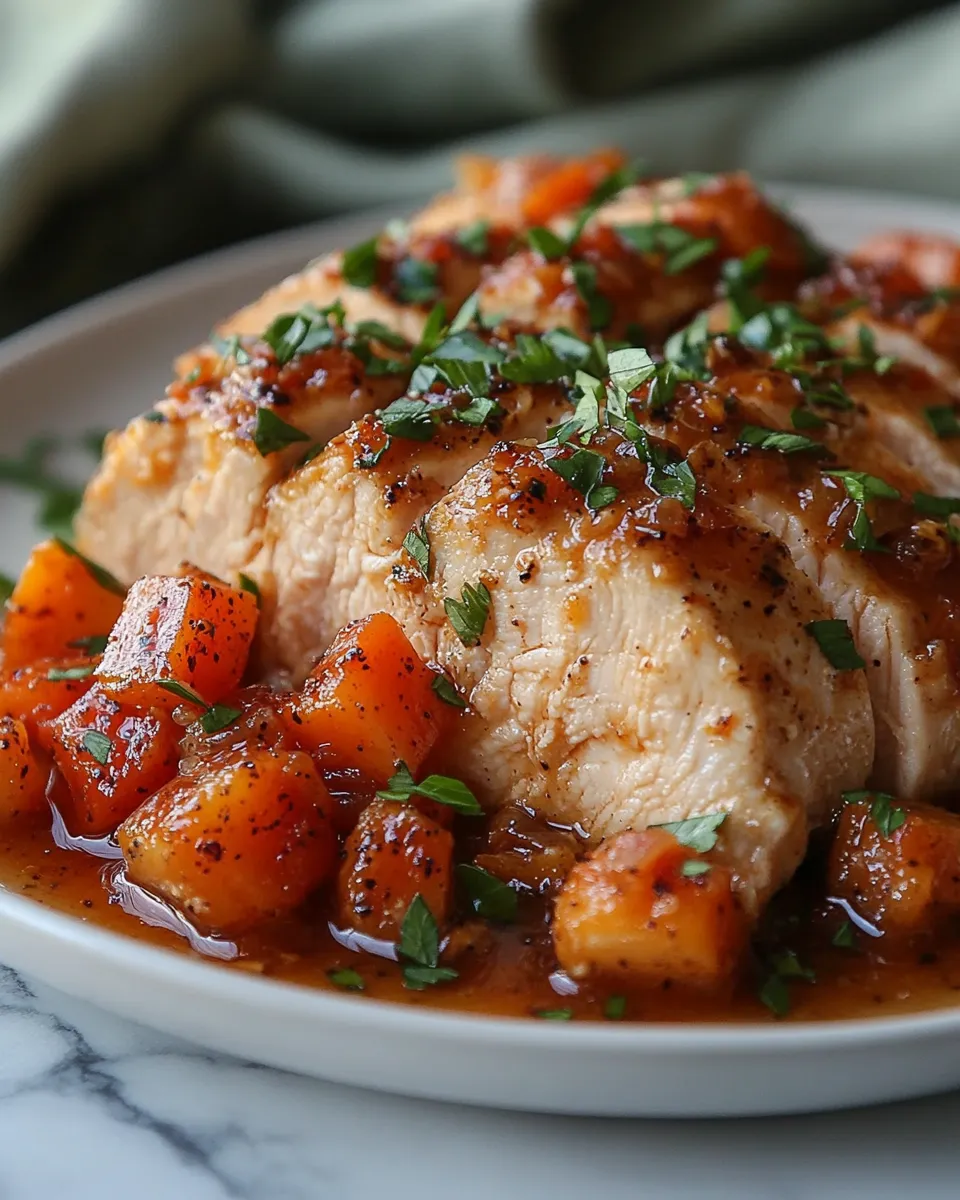There’s something undeniably comforting about a big bowl of homemade spaghetti. Whether it’s a chilly evening when you’re craving something warm and hearty, a relaxed Sunday dinner with the family, or just a quick yet satisfying meal after a long day, this spaghetti recipe fits the occasion. The aroma of simmering tomato sauce, the richness of perfectly cooked pasta, and the harmony of herbs and spices come together to create a dish that’s simple, delicious, and unforgettable.
This recipe is inspired by generations of home cooks who believed in the power of uncomplicated ingredients and the joy of sharing food with loved ones. My first memory of spaghetti wasn’t from a fancy restaurant—it was from my grandmother’s cozy kitchen, where the sauce simmered all afternoon and the table was set with love. That memory has become a tradition, and now I’m passing this classic along to you.
Why You’ll Love This Homemade Spaghetti
Making your own spaghetti from scratch might sound intimidating, but this recipe proves just how easy and rewarding it can be. Here’s what makes it a must-try:
-
Simple, pantry-friendly ingredients: No need for anything fancy—just real, wholesome ingredients you probably already have on hand.
-
Bold, classic flavor: Rich tomato sauce, fragrant garlic, and perfectly cooked pasta come together in perfect harmony.
-
Family-friendly and customizable: Whether you’re feeding picky eaters or adventurous palates, this dish is easy to adjust.
-
Great for meal prep: Make a big batch, store leftovers, and enjoy for days.
If you’ve never made spaghetti from scratch before, this recipe is the perfect starting point.
Ingredients: What You’ll Need
To keep things truly homemade, this recipe focuses on quality, everyday ingredients. Here’s everything you’ll need:
For the Sauce:
-
2 tablespoons olive oil
-
1 small onion, finely chopped
-
3 cloves garlic, minced
-
1 (28-ounce) can crushed tomatoes
-
1 tablespoon tomato paste
-
1 teaspoon dried oregano
-
1 teaspoon dried basil
-
½ teaspoon sugar (optional, to balance acidity)
-
Salt and black pepper to taste
-
1 bay leaf
-
¼ teaspoon red pepper flakes (optional, for a little heat)
-
Fresh parsley or basil, for garnish
For the Pasta:
-
12 ounces to 1 pound of dried spaghetti
-
Salt for pasta water
-
Freshly grated Parmesan cheese, for serving
Step-by-Step Instructions
1. Sauté the Aromatics
Start by selecting a large, heavy-bottomed saucepan or skillet. Add 2 tablespoons of olive oil and set it over medium heat. Allow the oil to warm up for about a minute—it should shimmer but not smoke.
Next, add the finely chopped onion to the pan. Stir to coat the pieces in oil and cook for 5 to 7 minutes, stirring occasionally. The onions should soften and become translucent, releasing their natural sweetness. This step is essential because it builds the first layer of flavor in your sauce. Be patient—don’t rush this process. Well-cooked onions offer a mellow, rich base that can’t be replicated with shortcuts.
Once the onions are soft and fragrant, add 3 cloves of minced garlic. Cook for 30 to 45 seconds, just until the garlic becomes fragrant. Stir constantly to prevent it from burning, as burnt garlic can turn the sauce bitter. The aroma at this point should be mouthwatering—savory and full of promise.
2. Build the Flavor
With your aromatics fully bloomed, it’s time to add depth. Stir in 1 tablespoon of tomato paste. This may not seem like much, but tomato paste packs a concentrated tomato flavor that enriches the sauce. Sauté the paste with the onions and garlic for 1 to 2 minutes. It will darken slightly and begin to caramelize, further intensifying the overall taste.
Next, pour in your 28-ounce can of crushed tomatoes. Stir to combine, then add the seasonings:
-
1 teaspoon dried oregano
-
1 teaspoon dried basil
-
¼ teaspoon red pepper flakes (optional, for subtle heat)
-
1 bay leaf
-
½ teaspoon sugar (optional, to balance acidity)
Season with salt and freshly ground black pepper to taste. Start with a light hand—you can always adjust later. Stir everything together, ensuring the tomato paste is fully incorporated and the spices are evenly distributed.
3. Let It Simmer
Turn the heat down to low, and allow the sauce to simmer gently, partially covered with a lid. This helps concentrate the flavors while preventing too much moisture loss. Let it cook for at least 25 to 30 minutes, though longer is even better if you have the time.
Stir the sauce occasionally to avoid scorching at the bottom. As it simmers, the tomatoes break down, the herbs infuse, and the sauce becomes thicker and richer. The kitchen will smell absolutely incredible. Just before serving, remember to remove the bay leaf and taste the sauce one last time, adjusting seasoning if necessary.
4. Cook the Spaghetti
While the sauce simmers, fill a large pot with water and bring it to a rolling boil. Add a generous pinch of salt—this is your chance to season the pasta from the inside out.
Drop in 12 to 16 ounces of dried spaghetti, stirring briefly to prevent sticking. Cook according to the package directions until the pasta is al dente—tender but still firm to the bite, usually around 8 to 10 minutes.
Before draining, carefully reserve ½ cup of the starchy pasta water. This liquid gold can be used to loosen the sauce and help it cling to the noodles. Then, drain the spaghetti well.
5. Combine and Serve
Return the drained pasta to the pot or place it in the pan with the sauce—either works. Gently toss until each strand is coated in the luscious tomato mixture. If the sauce seems too thick or dry, add a splash of the reserved pasta water a little at a time until you reach your desired consistency.
Now, plate it up while it’s still hot. Finish with a sprinkle of freshly grated Parmesan cheese and some chopped fresh parsley or basil for a pop of color and freshness. Serve immediately and enjoy the comforting magic of homemade spaghetti.
Tips for Success
Use Good Tomatoes
Quality canned tomatoes make a huge difference in flavor. Look for San Marzano or other premium crushed tomatoes for a naturally sweet and rich sauce.
Don’t Overcook the Pasta
Al dente pasta provides the best texture and helps the sauce cling beautifully to each strand. Keep a close eye and taste as you go.
Adjust Seasoning to Taste
Everyone’s palate is different. Add more herbs if you like, or skip the red pepper flakes for a milder sauce. Make it yours.
Double the Batch
The sauce freezes well and makes a great base for other dishes like lasagna, baked ziti, or stuffed shells. Make extra and store it in the freezer for up to 3 months.
Delicious Add-Ins and Variations
One of the best things about homemade spaghetti is its versatility. You can keep it classic or switch it up depending on what you have in your kitchen.
Add Protein:
-
Browned ground beef or Italian sausage for a meaty spaghetti sauce
-
Cooked and shredded chicken for a lighter twist
-
Plant-based ground meat for a vegetarian alternative
Boost the Veggies:
-
Diced bell peppers, mushrooms, or zucchini sautéed with the onions
-
A handful of spinach or kale stirred in at the end for extra nutrients
Try Whole Wheat or Gluten-Free Pasta:
Make this dish work for your dietary needs without sacrificing flavor or satisfaction.
Serving Suggestions: What to Eat with Spaghetti
A great spaghetti dinner deserves some equally great side dishes. Here are a few ideas to complete your meal:
Garlic Bread
Crispy, buttery, and perfect for soaking up that extra sauce.
Simple Green Salad
A refreshing contrast to the richness of the pasta. Try mixed greens with balsamic vinaigrette or a classic Caesar.
Roasted Vegetables
Oven-roasted broccoli, carrots, or Brussels sprouts make a hearty, healthy side.
Antipasto Platter
For a fancier touch, serve with olives, marinated artichokes, cheeses, and sliced meats before the main course.
Storage and Reheating
Leftovers
Store any leftover spaghetti in an airtight container in the refrigerator for up to 4 days.
Freezing
The sauce alone can be frozen for up to 3 months. Allow it to cool completely, then store in freezer-safe containers. Thaw overnight in the refrigerator before reheating.
Reheating
Reheat in a saucepan over medium heat, adding a splash of water or broth to loosen the sauce. You can also reheat individual portions in the microwave.
Frequently Asked Questions
Can I use fresh tomatoes instead of canned?
Yes, you can absolutely use fresh tomatoes in place of canned ones, especially during peak tomato season. Roma or plum tomatoes are ideal because they’re naturally sweet and less watery. To substitute, you’ll want to blanch the tomatoes first—score a small “X” on the bottom, boil for about 30 seconds, then transfer to an ice bath. Once peeled, chop or puree them, then cook them down a bit longer than canned tomatoes to achieve the same rich consistency. You may need to use about 2 to 2.5 pounds of fresh tomatoes for every 28-ounce can.
How do I prevent the sauce from being too acidic?
Tomato sauces can sometimes lean on the acidic side, especially when using canned tomatoes. To balance that tanginess, a small pinch of sugar—just about ½ teaspoon—can do wonders. It softens the sharp edge without making the sauce taste sweet. Some cooks also add a splash of milk or a small knob of butter at the end of cooking to mellow the flavors and round out the acidity even further. Taste as you go and adjust based on your preference.
Is this spaghetti recipe vegetarian?
Yes, this recipe is naturally vegetarian as long as you don’t include meat-based add-ins. If you’re following a strict vegetarian diet, be mindful of the Parmesan cheese, which often contains animal-derived rennet. Look for vegetarian-friendly alternatives or skip the cheese entirely—it’s still delicious without it.
Can I make this sauce in advance?
Definitely. In fact, this sauce tastes even better the next day after the flavors have had time to meld. Prepare it in advance and store it in an airtight container in the refrigerator for up to 4 days. You can also freeze it for longer storage—perfect for quick weeknight dinners.


